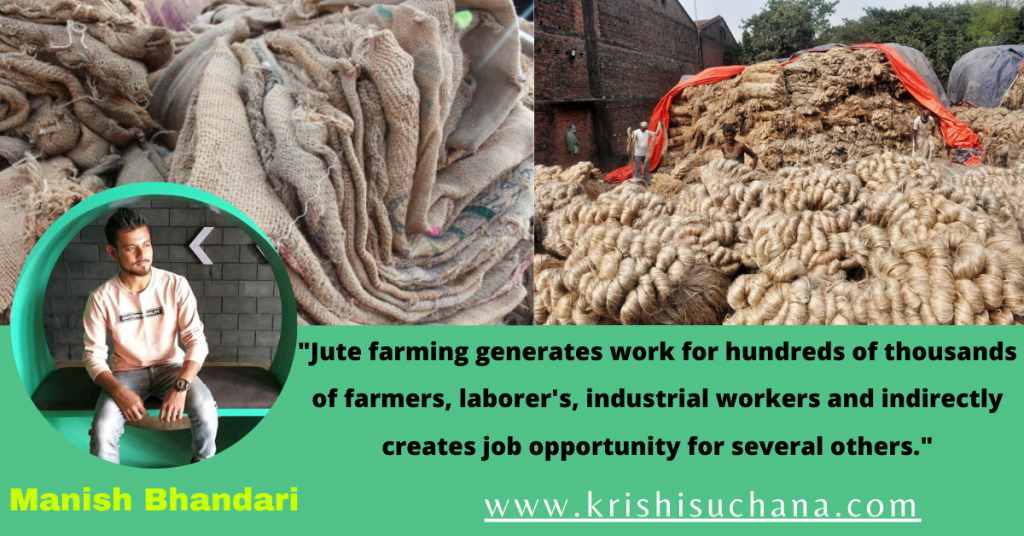JUTE: THE FIBER OF THE FUTURE

Jute, well known as ‘Golden Fiber’ is used for clothing, cordage and sacking. Jute is factually one of the most resourceful fibers nature gifted to man, which has several uses. After cotton, it is the cheapest and most significant of all textile fibers.
Jute is the lowest priced lignocellulosic, long vegetable bast uifibre accessible around the globe. Jute farming generates work for hundreds of thousands of farmers, laborer’s, industrial workers and indirectly creating job opportunity for several others.
Resourceful Options:
Massive acceptance of jute for wide ranges of life style consumer products is a result of great versatility of Jute. Spinning and weaving of the high quality yarns into light weight fine textured fabrics of standardized constitution in beautiful colors and designs are conducted in both handlooms and factories. Highly enhanced processes like bleaching, dyeing and finishing and by mixing jute with other synthetic and natural fibers, results better feel, shine, graze resistance and artistic appeal.
Handicrafts:
The traditional Nepali craftsmanship and art reflected in a huge range of jute clothing, handicraft, decorative materials and many more products. Exotic product assortment of jute comprises floor covering and carpets, window/door and wall coverings, table mats, swings, bags, hammocks, room décor, bedroom slippers, bedspreads, shawls, blankets, shirts, skirts and other clothing items, and an ideal host for many other home textile products.
Uses:
Jute can be considered as an eco-friendly natural fiber with hundreds of application prospects that ranges from geo-textiles to apparel, carpet, decorative items, upholstery, home furnishings, fancy non-woven etc. With versatility, jute deserves to be considered as the best fiber for the future.
In near future, a number of jute factories and mini jute mills will be witnessed more engaged in a considerable way in manufacturing of jute and blended yarns, especially via various ways of manufacturing to produce value added yarns. This versatile fiber can be used in many applications, however, the traditional usage has been sustained in packing as Hessian, sacking, and carpet backing. These light weight yarns are likely to be utilized in value added textile production like home-furnishing, upholstery, apparel and bags etc.
Research & Development – Jute Industry in Nepal
R&D conducted by reputed Nepal institutes has led to an intensification of the natural characteristics of jute fiber. Technological aid along with government’s developmental efforts, has made jute to cross the threshold of several range of applications, contributing to continue human development, generating employment opportunities and offering a cleaner environment.
Extensive R&D through many research institutes, most supported by Govt. Of Nepal, resulted in amazing penetration in the diversification of product assortment.
High-flying products are:
Hydrocarbons free for packing food grade products, such as coffee, coca, shelled nuts and many more. Manufacturing jute blended yarns, Jute-viscose, Jute-acrylic and jute cotton. Jute content differ from 60 to 70 percent in weight. These yarns are used in making shawls, blanket, thick materials and pullovers.
Manufacturing of fine blended yarns utilizing Jute-silk, Jute-wool, Jute-cotton etc. For garment utilization of jute content is nearly 30 to 40 percent.
Some of the ongoing projects are:
Using jute for making paper, Needle punched carpet from jute, Development of multi component yarn from jute, wool and other fibers for making floor covering, knitwear and blanket.
In a move to make jute product successful particularly in a textile segment jute has been massively experimented with. More push is required in diversification of jute product to face the challenge from the synthetic substitute due to their cheap price.
Writer: Manish Bhandari (Address : Kanchanpur, Gulariya, College : Gauradaha Agriculture Campus, Jhapa )

